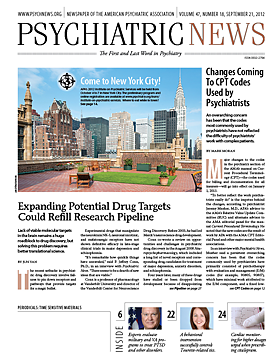It was an announcement that left many practitioners with little wiggle room: On August 24, 2011, the Food and Drug Administration (FDA) warned health care professionals and patients that the antidepressant Celexa (citalopram, a selective serotonin reuptake inhibitor also sold in generic form), “should no longer be used at doses greater than 40 mg per day because it can cause abnormal changes in the electrical activity of the heart.”
The FDA said the change from previous labeling, which stated that certain patients may require a dose of 60 mg per day, was based on postmarketing reports of QT interval prolongation and Torsade de Pointes associated with citalopram and its generic equivalents. In addition, the FDA said it had evaluated the results of a thorough QT study assessing the effects of 20 mg and 60 mg doses of citalopram on the QT interval in adults and determined that citalopram causes dose-dependent QT interval prolongation and should no longer be used at doses above 40 mg per day.
“It was very common for some practices to dose citalopram at 40 mg per day or higher,” Joel Yager, M.D., a professor of psychiatry at the University of Colorado at Denver School of Medicine, explained to Psychiatric News. “Some patients might have had a partial but definite response to 40 mg of citalopram. In these instances clinicians were understandably interested in seeing whether a higher dose might have produced even greater clinical response.” Yager is chair of APA’s Council on Research and Quality Care and of the Steering Committee on Practice Guidelines.
So the announcement left those physicians and their patients wondering what their response should be. One group that wasted no time in addressing the issue was the Veterans Health Administration. Its Pharmacy Benefits Management Services (PBM) distributed a “National PBM Bulletin” on August 31, 2011, reiterating the FDA communication. On September 29, it issued a second bulletin, saying that representatives from PBM, the Center for Medication Safety (VaMedSAFE), the Office of Mental Health Services, and the Office of the National Director of Cardiology had been in communication with the FDA and that those internal discussions resulted in the additional guidance provided in this latest bulletin (see Recommendations on Citalopram Dosing).
This document recommended avoiding prescribing higher doses and reducing high doses for existing patients when possible, but recognized that some patients require higher, off-label doses of citalopram and made recommendations on monitoring such patients.
Among other steps, the VA guidelines called for reduction of dose or even cessation of use of citalopram in patients whose QTc is greater than 500 msec. “In our setting, clinicians are switching patients who have any such issues from citalopram to alternative SSRIs such as sertraline, where concerns about prolonged QTc intervals have not been raised, and where there is increased latitude to increase the dose according to clinical response,” explained Yager.
The FDA updated its own recommendations on March 28, 2012, sending out another Drug Safety Communication, this one with specific guidance for patients: “Do not stop taking citalopram or change your dose without talking to your health care professional. Stopping citalopram suddenly can cause withdrawal effects.”
The FDA also announced changes to the citalopram drug label that included recognition that although citalopram use should be avoided in patients with certain conditions because of the risk of QT prolongation, ECG monitoring and/or electrolyte monitoring should be performed if citalopram must be used in such patients.
Despite any confusion that may have been the result of the FDA’s notices about citalopram dosing, Yager believes most clinicians are aware of the concerns and have been reviewing medication records, discussing the issue with patients, and making changes in prescriptions when indicated. Clinicians may also be prescribing citalopram less often: “My impression is also that fewer patients are now being started on citalopram than in the past,” Yager said.
Should practitioners turn away from citalopram entirely? “It’s always wise to practice safe prescribing,” said Yager. “When your patient is benefiting from citalopram within recommended dosage ranges, there is no reason to shift. But when you see a patient for whom higher SSRI doses might be needed in the future, it seems sensible to initiate treatment with a medication where the clinician isn’t going to be constrained by a recommended ceiling dose.”

Recommendations on Citalopram Dosing
In a September 29, 2011, bulletin, the Veterans Health Administration Pharmacy Benefits Management Services, Medical Advisory Panel, Center For Medication Safety, Office of Mental Health Services, and the Office of the National Director of Cardiology made the following recommendations regarding citalopram dosing and patient monitoring:
When possible, providers should refrain from prescribing citalopram in doses that exceed those in its label.
When possible, providers should attempt to reduce doses in any patients whose current dose exceeds that in its labeling to within label range.
VHA does recognize that some patients require higher doses (off-label) of citalopram. In these cases the following should be observed:
a.
The provider has decided that the benefits outweigh the risk of harm (QTc prolongation, Torsade de Pointes) and has discussed this with the patient or caregiver.
b.
The above (a) has been documented in CPRS by the provider. (a and b apply to current and future patients.)
c.
For patients already on higher (off-label) doses of citalopram, an ECG will be done to document that the QTc is less than 500 msec. Prior to increasing citalopram to higher off-label doses, an ECG has been obtained and read prior to initiating the higher dose of citalopram. (An ECG obtained within the previous three months is acceptable.)
d.
For future patients, an ECG is to be obtained and read prior to initiating the higher dose of citalopram. (An ECG obtained within the previous three months is acceptable.)
e.
Serum potassium and magnesium concentrations have been obtained and abnormal concentrations corrected prior to initiating the higher dose of citalopram.
f.
That periodic ECG and labs will be obtained during the course of therapy and prior to any additional dose increases.
g.
If at any time the patient’s QTc is greater than 500 msec or if other risk factors for QTc prolongation are present (e.g., another drug that prolongs QTc is required), the dose will be reduced or citalopram will be discontinued.
h.
The patient’s need for a higher dose should be assessed periodically and a dose reduction considered if appropriate.

